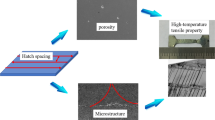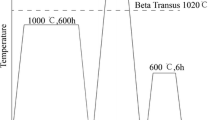Abstract
A study of the impact properties of DOP-26 iridium (which contains 0.3% tungsten and ∼40 ppm thorium) at temperatures of 600 to 1,440†C revealed that the predominant mode of failure for the material is intergranular separation with occasional transgranular cleavage. DOP-26 iridium also appears to have a high notch sensitivity, in contrast to most other face-centered-cubic (fcc) metals; at elevated deformation temperatures, the dislocation substructure is similar to that of other fcc metals. In addition, regular arrays of pure edge character dislocations have been found. In the test specimens used in this study, the presence of Ir5Th particles was observed within iridium grains. The existence of these particles indicates that the role of thorium is not well understood, particularly in light of the fact that previous studies, which depended on grain boundary segregation, have shown thorium to improve grain boundary cohesion.
Similar content being viewed by others
References
Metals Handbook, Ninth Edition, Volume 2, American Society for Metals (1979), p. 740.
A.H. Cottrell, The Mechanical Properties of Matter, (New York: John Wiley and Sons, 1964), p. 7.
General Electric Corp., Multihundred Watt Radioisotope Thermoelectric Generator Program, Doc. No. GEMS-419, Vol. 1, Philadelphia, PA, 1975.
R.W. Douglas, A. Krier and R.I. Jaffee, Battelle Memorial Institute Report NP-10939, Aug. 1961.
S.P. Lynch, Metal Science, 15 (1981), pp. 463–467.
C. Gandhi and M.F. Ashby, Scripta Met., 13 (1979), pp. 371–376.
S.S. Hecker, D.L. Rohr and D.F. Stein, Met. Trans. A, 9A (1978), pp. 481–488.
C.L. White and C.T. Liu, Scripta Met., 12 (1978), pp. 727–733.
C.L. White, R.E. Clausin and L. Heatherly, Met Trans. A, 10A, (1979), pp. 683–691.
C.T. Liu, H. Inouye and A.C. Schaffhauser, Met. Trans. A, 12A, (1981), pp. 993–1002.
D.L. Rohr, L.E. Murr and S.S. Hecker, Met. Trans. A, 10A (1979), pp. 399–405.
M.E. Eberhart and D.D. Vvedensky, submitted to Acta Met., 1987.
T.G. George, Los Alamos National Laboratory Report LA-11065, 1988.
C.T.J. Ahlers and R.W. Balluffi, J. Appl. Phys., 38 (1967), p. 910.
R.E. Zielinski and V.K. Sikka, J. Less-Common Metals, 31 (1973), pp. 393–395.
L.E. Murr, J. Less-Common Metals, 34 (1974), pp. 177–179.
D.N. Braski and G.A. Potter, “Jet-Polishing Iridium for TEM,” Proc. Thirty-Third Annual EMSA Meeting, 33 (1975), pp. 230–231.
D. Hull, Introduction to Dislocations, 2nd Edition (New York: Pergamon Press, 1975), p. 232.
L.E. Murr, Interfacial Phenomena in Metals and Alloys, (Reading, MA: Addison-Wesley Publishing Co., 1975), p. 146.
A.E. Dwight, Trans. ASM, 53 (1961), pp. 479–500.
Additional information
Timothy G. George received his B.S. in metallurgy from the University of Pittsburgh in 1980. He is currently a staff member with the Los Alamos National Laboratory in Los Alamos, New Mexico.
Michael F. Stevens received his Ph.D. in metallurgy from Carnegie-Mellon University in 1984. He is currently a staff member with the Los Alamos National Laboratory in Los Alamos, New Mexico. Dr. Stevens is also a member of TMS.
Rights and permissions
About this article
Cite this article
George, T.G., Stevens, M.F. The High-Temperature Impact Properties of DOP-26 Iridium. JOM 40, 32–35 (1988). https://doi.org/10.1007/BF03257981
Published:
Issue Date:
DOI: https://doi.org/10.1007/BF03257981




